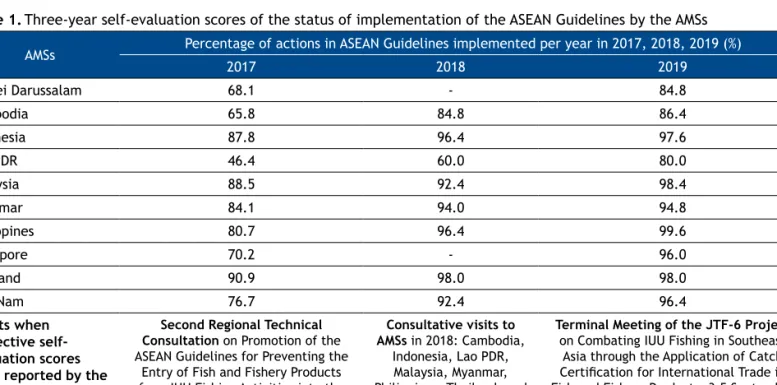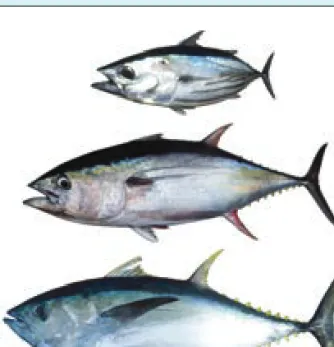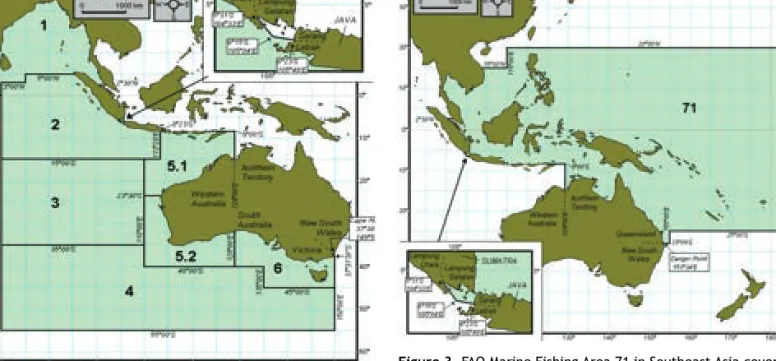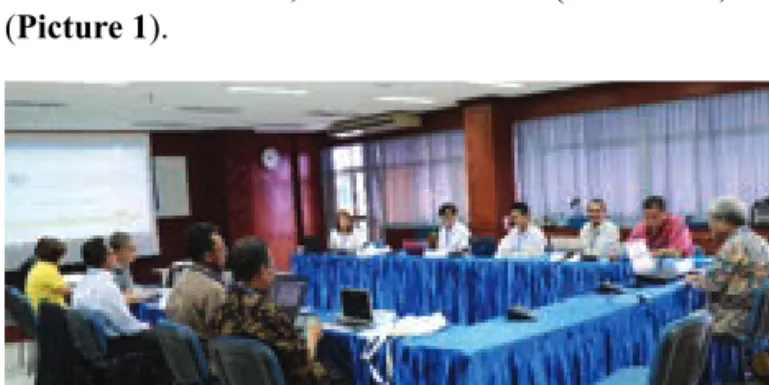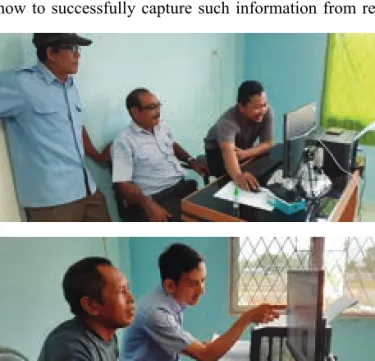As stipulated in the IPOA-IUU, the implementation of PSM is one of the effective means to combat IUU fishing. Summary of the way forward to address IUU fishing in Southeast Asia (adapted from SEAFDEC/TD (2020a)) at national level.
ASEAN Regional Plan of Action for the Management of Fishing Capacity (RPOA-Capacity), Southeast Asian Fisheries Development Centre. Report of the forty-third meeting of the program committee of the Southeast Asian Fisheries Development Center (online meeting), 10-12 November 2020 (unpublished).
About the Authors
Securing the space of ASEAN fish and fishery products in the global market: ASEAN catch documentation scheme for marine capture fisheries. Towards guaranteed traceability of fish and fishery products from Southeast Asia: ASEAN Catch Documentation Scheme.
Towards Guaranteed Traceability of Fish and Fishery Products from Southeast Asia: the ASEAN Catch Documentation Scheme
Development and Promotion of the ASEAN Guidelines
Towards guaranteed traceability of fish and fishery products from Southeast Asia: the ASEAN catch documentation programme. 2016a). Finally, after considering the ASEAN Guidelines (Figure 1) by the SEAFDEC Council at its forty-seventh meeting in April 2015, the ASEAN Guidelines were endorsed by the 23rd Meeting of the ASEAN Sectoral Working Group on Fisheries (ASWGFi) in June 2015. for consideration by the ASEAN senior level meetings. Triennial self-assessment scores of the status of implementation of the ASEAN Guidelines by the AMSs AMSs Percentage of actions in the ASEAN Guidelines implemented per year in.
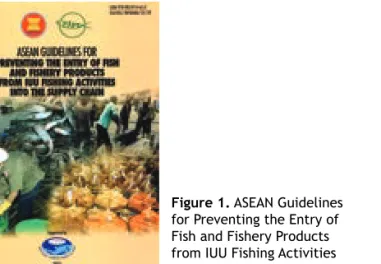
Establishment and Dissemination of the ASEAN Catch Documentation Scheme
It is for consumers/importers to trace the origin of the fish and fishery products. The implementation of the ASEAN Guidelines for preventing the entry of fish and fishery products from IUU fishing activities into the supply chain in the AMSs was monitored and feedback compiled. Box 3: Issues, concerns and difficulties faced by AMSs in implementing the ASEAN Guidelines-Legal Framework.
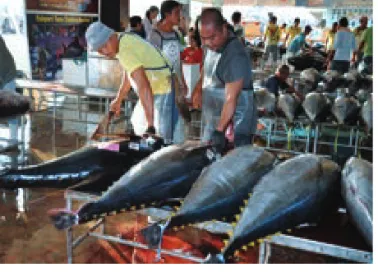
Conclusion and Recommendations
Development of the ASEAN Catch Documentation Scheme (ACDS) initiated by SEAFDEC/MFRDMD in collaboration with the SEAFDEC Secretariat. Some AMSs lack the necessary legal framework for implementing some parts of the ASEAN guidelines, e.g. Another challenge that the AMSs face in the implementation of the guidelines is raising awareness among the stakeholders.
Way Forward
Key results of the project “Fighting IUU fishing in the Southeast Asian region through the application of catch certification for international fish trade and fisheries. Report of the Second Regional Technical Consultation on the Promotion of the “ASEAN Guidelines to Prevent the Entry of Fish and Fishery Products from IUU Fishing Activities into the Supply Chain”, 21-23 November 2017, Kuala Lumpur, Malaysia. The Terminal Meeting Report of the JTF VI Project on Combating IUU Fishing in Southeast Asia through the Application of Catch Certification for International Trade in Fish and Fishery Products, September 3-5, 2019, Kuala Lumpur, Malaysia.
Enhancing Regional Capability in Monitoring and Analysis of Contaminants in Seafood: Southeast Asian Perspective
Monitoring Chemical and Drug Residues in Fish and Fish Products of Southeast
A total of 35 fish and fish products were surveyed in seven participating countries, namely: Cambodia, Malaysia, Myanmar, Philippines, Singapore, Thailand and Vietnam. The survey results showed that histamine levels in fish and fish products from AMS were within acceptable limits (Tan . & Saw, 2008). The survey results had also provided assurance and confidence in the safety of fish and fish products from AMSs.
Biotoxins Monitoring in the ASEAN – Phase I
A total of 15 fish and fish products were investigated, and the results of the survey showed that drug residues in fish and fish products from almost all AMS were within the standard limits set by the EU and other importing countries (Tan & Saw, 2008). From the results of surveys on heavy metals, pesticide residues, histamine and drug residues carried out in the participating AMS, it was found that some samples exceeded national or international regulatory limits. From the results of the PSP survey of mussels (Perna virdis) and mussels (Meritrix meritrix) conducted by participating AMS, it was found that some samples exceeded the allowed regulatory limits.
Biotoxins Monitoring in the ASEAN – Phase II
As an end result of the project, this technical collection would benefit policy makers, technologists and scientists as well as regulatory staff in the fisheries sector. The “Technical Compendium of Biotoxin Monitoring in the ASEAN Region” (Ong & Chai, 2019) was published at the end of the project in 2019 as a joint effort of participating AMS to improve regional capacity for testing and analysis of ASP, AZA and BTX Biotoxins as well as identification of toxic HAB species. The project also strengthened fish quality and safety management systems that support the competitive position of ASEAN fish and fish products in the global market, as set out in the ASEAN Food Security Resolution and Action Plan towards 2020 ( SEAFDEC, 2011 ).
About the Author
In addition, a number of technical personnel from the AMS have been trained in AZA, ASP and BTX biotoxin assays and in the identification of toxic HABs. In addition, the list of responsible national authorities and HAB experts in the SEAFDEC member countries is also part of the said compilation. Marine Fisheries Research Department, Southeast Asian Fisheries Development Centre, Singapore; 242 pp. ASEAN-SEAFDEC Resolution and Plan of Action on Sustainable Fisheries for Food Security in the New Millennium.
Unveiling the Stock Status of Oceanic Tuna Resources in Sulu-Sulawesi Seas
Sustainable Utilization of SKJ, YFT and BET Resources in the Sulu-Sulawesi (SSS) Sub-Regional Area” with financial support from Japan Trust Fund (JTF) II.
Assessment and Sustainable Utilization of SKJ, YFT, and BET Resources in the SSS
Therefore, the stock status of these three bluefin tuna species in the SSS is likely to be reflected by the integration of these factors. SKJ, YFT and BET catch trend in Philippine, Malaysian and Indonesian SSS and (right) Comparison of catch by species between SSS and WCPFC. In SSS, the latest stock statuses of YFT (2015) and BET (2017) were in the safe (green) zones, although the stock status of SKJ was in the unsafe (yellow) zone.
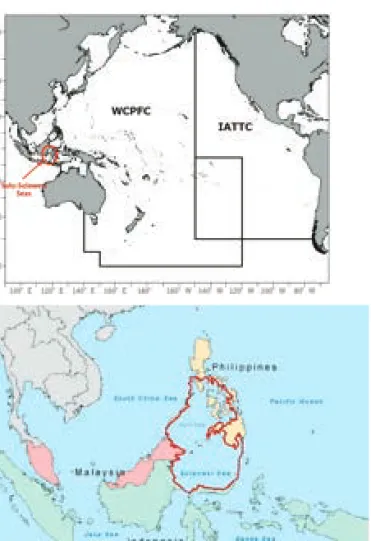
Final Remarks
However, it is very likely that the status of tuna species in the SSS for SKJ and BET was much worse than in the entire WC Pacific, i.e. from the point of view of precautionary approaches it is recommended that the total catch limits in the SSS should not be increased compared of the (localized) MSY levels per species, as shown in Table 2. Boosting the management of economically important fisheries resources in the Southeast Asian region: the seer fish in focus.
Efficient Inland Fisheries Data Collection Made Easy
Data Collection on Inland Fisheries
Furthermore, the number of fishermen is large, as these include occasional fishermen and vary considerably during the different seasons, resulting in inconsistencies in information regarding, among other things, catch size and composition and types of gear used. Furthermore, since the catch usually includes several species of fish that go directly to different market channels, information about the catch is not properly recorded (Muthmainnah et al., 2019) as there are no centralized landing ports or major markets where data can be easily collected . Large parts of the catch are also brought home by the fishermen for household consumption and for traditional processing after harvest into fermented and salted fish for direct consumption.
Development of DACOFA
For many Southeast Asian countries, the importance of catch statistics from inland capture fisheries is not well understood and less evaluated, which may be because such data are fragmented and discontinuous, contributing to the alarmingly dismal state of the overall status of the region s small-scale fisheries. Often the catches are bought on the spot or exchanged locally by buyers or in most cases they are brought directly by fishermen to the local markets.
Overview of the Implications of DACOFA
In this regard, staff from the data center and researchers from SEAFDEC/IFRDMD conducted such training courses (Figure 1). Assisted by IFRDMD staff, trainees use their Android mobile phones with the DACOFA app installed to input data on fishing activities from Patratani village in the south. Since July 2020, SEAFDEC/IFRDMD has been pilot testing the use of DACOFA to collect fishing data in inland waters from the village of Patratani, South Sumatra, Indonesia.
The DACOFA Application Menu
Select the "OK" button after you have finished entering the data and the screen will go to the next page containing the information about the fish name, total catch, fish price, currency type and the button to search for previous data. or next data. Complete the data form completely; and if there is no information on the price of the fish, please enter the zero number “0” (Figure 5). If there are no data revisions or cancellations, please click "VALIDATE" (Figure 7) and finally, the data will be stored in the SEAFDEC/IFRDMD database.
Challenges in the Application of DACOFA
Acknowledgement
Dina Muthmainnah is Head of Research and Development at SEAFDEC/IFRDMD and Senior Researcher, Inland Fisheries Research Institute and Extension, Ministry of Marine Affairs and Fisheries, Palembang, Indonesia. Sevi Sawestri is the Head of the Fisheries, Limnology and Environment Unit at SEAFDEC/IFRDMD and a researcher at the Inland Fisheries Research Institute and Extension, Ministry of Marine Affairs and Fisheries, Palembang, Indonesia. Rais is a researcher at the Inland Fisheries and Extension Research Institute, Ministry of Marine Affairs and Fisheries, Palembang, Indonesia.
Moving Towards the Renewed Resolution and Plan of Action on Sustainable Fisheries for Food Security for the
ASEAN-SEAFDEC Policy Documents established during 2001-2020
Achievements of ASEAN and SEAFDEC since the adoption of the resolutions and plans of action in ASEAN-SEAFDEC Resolution and Plan of Action on Sustainable Fisheries for Food Security for the ASEAN Region (2001 Resolution and Plan of Action. Furthermore, the 2001 Resolution and plan of Action was also used as the framework for the development and implementation of the Special Five-Year Program on the Contribution of Sustainable Fisheries to Food Security for the ASEAN region, as well as in the review of the fisheries regulations of the respective AMSs. the promotion of the 2001 resolution and plan of action, the visibility of SEAFDEC was enhanced, specifically through the.
Resolution and Plan of Action on
The title of the special publication follows the theme of the ASEAN-SEAFDEC conference series on achieving sustainable fisheries and food security in the ASEAN region. Meanwhile, cooperation between SEAFDEC and ASEAN has been strengthened with the formalization of the ASEAN-SEAFDEC Strategic Partnership. The concept of ecosystem approach to fisheries management (EAFM) has been identified as one of the key aspects adopted to develop policies and frameworks.
Sustainable Fisheries for Food Security for the ASEAN Region Towards 2030
Support the Sustainable Fisheries Action Plan for Food Security for the ASEAN Region towards 2030, which was adopted by senior officials of ASEAN-SEAFDEC member countries on 5 August 2020; and to. which recognizes the progress made by ASEAN Member States (AMSs) in the implementation of the Action Plan on Sustainable Fisheries for Food Security for the ASEAN Region towards 2020. Resolution and Action Plan on Sustainable Fisheries for Food Security for the ASEAN Region towards 2030 (cont. ).
CALENDAR OF EVENTS
Sustainable management and development of fisheries and aquaculture to contribute to food security, poverty alleviation and livelihoods of people in the South East Asian region. Technology transfer and capacity building to improve the capacity of Member States in the application of technologies, and implementation of fisheries policy and management tools for the sustainable utilization of fisheries resources and aquaculture. Monitoring and evaluating the implementation of the regional fisheries policies and management frameworks adopted under the ASEAN-SEAFDEC cooperation mechanism, and the emerging international fisheries-related issues, including their impact on fisheries, food security and socio-economics of the region.
